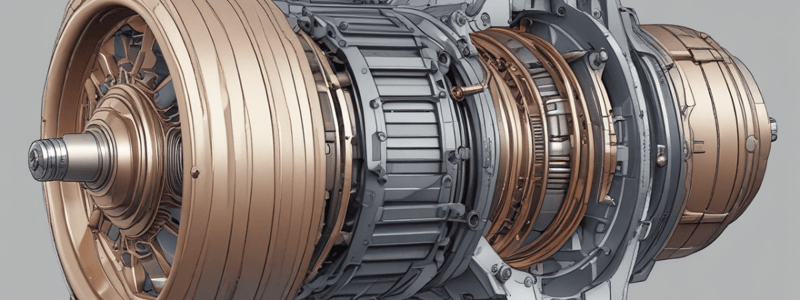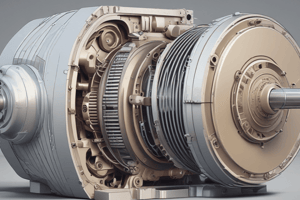Podcast
Questions and Answers
What is the result of having rotor bars placed near the surface of the rotor?
What is the result of having rotor bars placed near the surface of the rotor?
- High leakage reactance and high starting torque
- Low leakage reactance and high starting torque
- Low leakage reactance and low starting torque (correct)
- High leakage reactance and low starting torque
What is the primary factor that determines the leakage reactance of a rotor bar?
What is the primary factor that determines the leakage reactance of a rotor bar?
- Number of rotor bars
- Cross-sectional area of the bar
- Distance from the stator (correct)
- Material used to construct the bar
What is the effect of a low rotor resistance on the motor's characteristics?
What is the effect of a low rotor resistance on the motor's characteristics?
- Lower starting torque and lower efficiency
- Higher starting torque and lower efficiency
- Higher starting torque and higher efficiency
- Lower starting torque and higher efficiency (correct)
What is the term for the reactance due to the rotor flux lines that do not couple with the stator windings?
What is the term for the reactance due to the rotor flux lines that do not couple with the stator windings?
What is the result of increasing the distance between the rotor bars and the stator?
What is the result of increasing the distance between the rotor bars and the stator?
What is the purpose of controlling leakage reactance in induction motor rotor design?
What is the purpose of controlling leakage reactance in induction motor rotor design?
What is the NEMA design class A characterized by?
What is the NEMA design class A characterized by?
What is the effect of a small rotor bar cross-sectional area on the motor's characteristics?
What is the effect of a small rotor bar cross-sectional area on the motor's characteristics?
What is the effect of high rotor resistance on a motor's efficiency?
What is the effect of high rotor resistance on a motor's efficiency?
Why are wound-rotor motors not commonly used?
Why are wound-rotor motors not commonly used?
What is the primary advantage of a NEMA design class D motor?
What is the primary advantage of a NEMA design class D motor?
How does the rotor resistance change at high slip (starting conditions)?
How does the rotor resistance change at high slip (starting conditions)?
What is the ideal behavior of a motor during starting and normal operation?
What is the ideal behavior of a motor during starting and normal operation?
What is the purpose of adding extra resistance to the rotor in a wound-rotor induction motor?
What is the purpose of adding extra resistance to the rotor in a wound-rotor induction motor?
What is the advantage of a motor with low rotor resistance?
What is the advantage of a motor with low rotor resistance?
Why is the rotor resistance relatively high in a cage motor with a specific rotor construction?
Why is the rotor resistance relatively high in a cage motor with a specific rotor construction?
Why is it important to be able to add extra rotor resistance during starting?
Why is it important to be able to add extra rotor resistance during starting?
What is the challenge faced by an induction motor designer?
What is the challenge faced by an induction motor designer?
What happens to the current flow in the rotor bars at low slip?
What happens to the current flow in the rotor bars at low slip?
What is the effect of slip on a motor's efficiency?
What is the effect of slip on a motor's efficiency?
What is the main difference between a class A and class D design?
What is the main difference between a class A and class D design?
Why is it desirable to completely seal a motor in certain environments?
Why is it desirable to completely seal a motor in certain environments?
Why is the rotor leakage reactance small in a cage motor?
Why is the rotor leakage reactance small in a cage motor?
How can a variable rotor resistance be achieved?
How can a variable rotor resistance be achieved?
Flashcards are hidden until you start studying
Study Notes
Control of Motor Characteristics by Cage Rotor Design
- Leakage reactance is the reactance due to the rotor flux lines that do not also couple with the stator windings.
- The farther away from the stator a rotor bar or part of a bar is, the greater its leakage reactance.
- If the bars of a cage rotor are placed near the surface of the rotor, they will have only a small leakage flux and the reactance X2 will be small in the equivalent circuit.
Rotor Design Characteristics
- A rotor design with large bars placed near the surface of the rotor (NEMA design class A) will have a low resistance and a low leakage reactance, resulting in a high pullout torque near synchronous speed and high efficiency.
- A rotor design with small bars placed near the surface of the rotor (NEMA design class D) will have a high rotor resistance, resulting in a high starting torque and low starting current.
Variable Rotor Resistance
- At low slips, the rotor's frequency is very small, and the reactances of all the parallel paths through the bar are small compared to their resistances, resulting in a large cross-sectional area and low rotor resistance.
- At high slips (starting conditions), the reactances are large compared to the resistances in the rotor bars, resulting in a higher rotor resistance and higher starting torque.
NEMA Design Classes
- A rotor designed with high resistance will have a high starting torque but poor efficiency at normal operating conditions.
- A rotor designed with low resistance will have a low starting torque and high starting current, but high efficiency at normal operating conditions.
Compromise Between Starting Torque and Efficiency
- An induction motor designer must compromise between high starting torque and good efficiency.
- One possible solution is to use a wound-rotor induction motor and insert extra resistance into the rotor during starting, but this has drawbacks such as increased cost and complexity.
Desired Motor Characteristics
- The desired motor should behave like a high-resistance wound-rotor motor at high slips and like a low-resistance wound-rotor motor at low slips.
- The goal is to add extra rotor resistance at starting and remove it during normal running without slip rings and without operator or control circuit intervention.
Studying That Suits You
Use AI to generate personalized quizzes and flashcards to suit your learning preferences.





